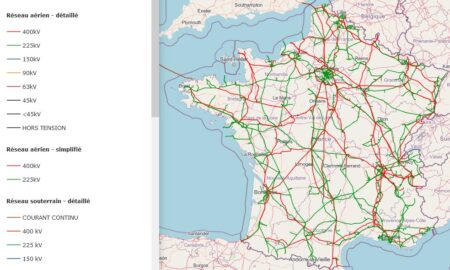RTE Ten-Year Plan & development of the French electricity transmission network
Author: Alexandre LULL — 22 April 2024

To meet its electrification and decarbonisation needs, France will have to increase its electricity production by 33% in less than 15 years (i.e. +140 TWh).
The public debate focuses a great deal on electricity generation, but a critical link in the system is all too often overlooked: electricity transmission infrastructure!
We know that until the next French nuclear power plants are commissioned (in 2035 at the earliest), the likely increase in demand for electricity in the country will have to be supplied by renewable sources, in particular wind power and photovoltaic solar power.
What is often overlooked is that these modes of production are by their very nature diffuse and intermittent, and this implies a the profound changes to the electric grid, which will move from a centralised system designed around nuclear power stations located close to main cities towards a much more decentralised system interconnected with France’s European neighbours.
If we add to that the effects of climate change, France is now facing a real challenge in terms of adapting its electric grid, both to strengthen it and make it more flexible.
The evolution of the French electrical transmission network
France’s 2 main electrical system operators (RTE for transmission and Enedis for distribution) are planning to invest several hundred billion Euros to avoid costly and potentially catastrophic congestion.
It is well known that an inadequate electric grid raises the cost of electricity for consumers by because it limits or delays the connection of new renewable generation capacity and forces installed capacity to be topped up during periods of high production production, i.e. sacrificing part of the renewable electricity production, which induces extra costs at all levels.
In its latest Ten-Year Network Development Plan published in 2024, RTE refers to these constraints on its transmission network (63 kV, 90 kV and 225 kV), which is responsible for connecting renewable sources.
The 100 billion investment wave mentioned by RTE is a unique opportunity to unique opportunity to modernise France’s network, using technologies that will significantly improve the efficiency of electricity transmission for the next 50 years and beyond, enabling it to adapt to the new energy mix while reducing line losses.
A key role for advanced conductors
Among the most promising existing solutions are composite core conductors. These new-generation conductors replace old legacy metal conductors that have reached the end of their life, in order to:
- Quickly and cost-effectively double a line’s ampacity, thereby being able to absorb peaks in renewable generation.
- Without replacing existing structures.
- Reduce electrical losses by 30% under normal operation.
The technology has been tried and tested around the world for over 20 years, and most Western countries are already deploying it on a massive scale on their networks, such as: Belgium (Elia), the Netherlands (Tennet), Germany (Amprion and 50Hertz), Italy (Terna), the United Kingdom (National Grid and Scottish Power), Norway (Statnett), United States (AEP, SCE and many other TSOs), Korea (KEPCO)…
But these solutions are not reserved to the most advanced countries, as they also enable countries with strong economic development to support a rapid electrification (by doubling the capacity of existing lines), and can offer a return on investment in just a few years thanks to the reduction in electrical losses. Regular users include TSOs such as PLN (Indonesia), EVN (Vietnam), ANDE (Paraguay) and CFE (Mexico), as well as numerous operators in Africa and the Indian subcontinent (India, Nepal, Bangladesh), where tens of thousands of kilometers of composite core conductors have already been installed.
Advanced conductors: a French sector of excellence
France hosts several world leading manufacturers in this industry, with a historic partnership between 3 renowned companies: Epsilon Composite for the carbon fibre core, Nexans for conductor stranding, and Sicame for line accessories.
RTE installed a pilot project on a 90kV line using conductors and accessories supplied by these these 3 French companies, which have also invested massively in their production production capacity and have engaged the “Smart Cable” collaborative R&D program in order to meet even better the future needs of our TSOs.
In the meantime, existing advanced composite core conductor technologies are already mature. They have been extensively tested and deployed throughout the world for 2 decades and are just waiting to be deployed on a larger scale in France to support its energy transition and strategic goals.

About the Author, Alexandre LULL
Alexandre is Deputy CEO of Epsilon Composite. After studying composite materials, aerospace engineering and business management, he began his career in the Airbus group, before joining Epsilon Composite. He is closely involved in the activities of Epsilon Cable to support the modernisation of electrical infrastructures. As a leader, Alexandre is focused on developing the company’s global performance, integrating extra-financial criteria and sustainable development into its strategy.
